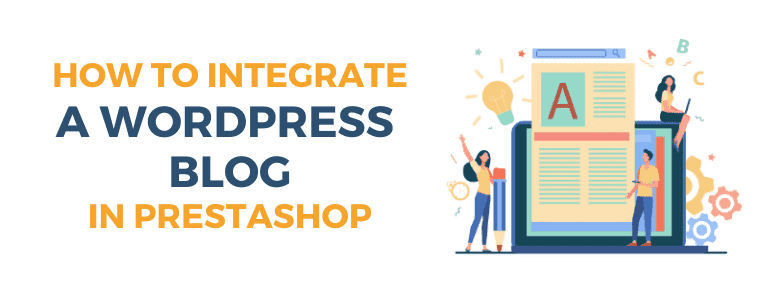In this post I’m going to explain what options we have to add a blog in PrestaShop and how to integrate it into your PrestaShop online store, focusing on the WordPress option.
This is necessary not only because having a corporate blog for an E-commerce is important, we’ll talk about this later, – although if you want detailed information, you can visit Reasons why an E-commerce should have a blog.
It’s also an important topi because the PrestaShop 1.6 and PrestaShop 1.7 versions don’t incorporate the installation of a blog in its features by default. But to improve the organic positioning of your online store, a blog is practically essential.
So, to make this clear, we’re going to start talking about why it0s important to have a blog in your PrestaShop store.
Table of contents
Importance of implementing a blog in PrestaShop

The main task or function of a blog is to attract traffic to your online store. It’s as fundamental as having a payment gateway, we could say.
Let me explain: through a blog, what we intend explicitly is to solve the possible doubts that our potential customers have about the products or services we offer, and more or less directly, offer said products and services to them, by redirecting them to our online store.
A large percentage of potential customers base their purchases on the comments or information provided through the blog, and since the blog captures much of the web traffic, it’s our responsibility to know how to take advantage of it.
The importance of a blog lies in factors such as internal linking between one post and another or to the online store, as we are producing links (connections) between several pages, which increases the navigation time of users on the website.
On the other hand, if we establish a strategy of publishing on a regular basis, that is, we have an updated and “alive” blog, we’ll be sending pings (signals) to Google crawlers that our website is being updated.
This will make Google crawl the website more frequently and consequently detect optimizations or changes more quickly and smoothly.
In short, blogs are a fundamental part of digital marketing, not only is beneficial regarding Google, it also increase your audience of potential customers.
Now that we know the importance of a blog for an E-commerce (in summary) let’s see possible options to integrate a blog in PrestaShop.
Alternatives to implement a blog in PrestaShop
As always, there are many options to add a blog to PrestaShop, but here we’re going to focus on the ones I think are the easiest, most interesting and practical.
- Using free modules:
We have at our disposal several modules for the integration of a blog that can serve us perfectly in our online store.
I want to recommend one in particular, Smartblog free module. This module besides is free and available in version 1.6 of PrestaShop and the version 1.7, but it’s possible that it is not fully updated for the latter version and has some bugs. So we won’t talk further about it.
- Blog module Wherehouse Template:
In this template we have a specific module for creating a blog, ie, using this template you already have a blog, you don’t need to install an additional module.
In addition, this module integrated in the Wherehouse template has a greater number of blog integrations with the online store than the Smartblog module.
For example, it displays blog entries in the home page through the integrated builder. It also allows us to display posts in the sidebar as well as related posts.
- Integrating a WordPress blog in PrestaShop:
There’s also the possibility to install a WordPress as a folder within the main domain where you have your PrestaShop store.
Although it may seem a complicated or tedious process, this type of installations are simple, thanks to the automatic installers that the vast majority of hostings include currently.
And since this will be our main subject in this post, I want to go deeper into this option, explaining the most significant advantages and disadvantages of implementing a WordPress blog in your PrestaShop store.
Key features of a WordPress blog in PrestaShop
Your main project is the sale of products or services through your online store, so all actions must follow this objective. If you create a blog in another space it will be odd for your users and it will have a negative impact on the SEO of your website. That’s why it’s best to have a blog hosted in a folder on your main domain. Which is possible by integrating a blog in WordPress
On the other hand and more specifically, WordPress is undoubtedly the blog CMS with more possibilities.
Power and flexibility is one of its fundamental advantages, since WordPress has plenty of free and paid plugins and themes that will allow you to add virtually any functionality and design to your ecommerce blog. So we’ll be getting a blog with very serious possibilities of being scaled and grow.
Thanks to these features that we get when installing different plugins, making your blog rank in an organic way will be an easier task. If you want a scalable blog to which you can add new features, this is your best option.
The most significant drawback of adding a WordPress blog to your PrestaShop store may be the design.
As I said, WordPress has a variety of templates or themes both free and paid, but it won’t be easy to adapt the blog design to the one in our store in PrestaShop. Please notice that I said it won’t be easy, but not impossible. What you need to reach this goal is a professional service like the web design in PrestaShop or knowledge of the WordPress CMS.
Another disadvantage but of lesser importance is that the management of the blog will have to be done from the WordPress control panel, ie, a different administration panel of PrestaShop.
So when adding a blog in WordPress you’ll need to train yourself in its CMS to learn and be able to manage the blog properly.
And now, without further ado, let’s see how to install a WordPress blog in PrestaShop.
Install WordPress blog in PrestaShop
Taking into account that WordPress is the most used blogging platform in the world, we’ll see below the technical steps to integrate a WordPress blog in your PrestaShop store.
As I said, it isn’t as complex as it may seem, you only need to follow this step by step guide.
- Install WordPress
First, you must download the latest version of WordPress from the official website.
Once you have downloaded the latest version of WordPress, at the control panel of the hosting from where you have downloaded it, you’ll have to access your FTP. There, you need to create within the root directory of the store a new folder called /blog/ in where you have to upload the WordPress files that have been previously downloaded.
- Configuring WordPress
This way, if your version of the blog in the online store is for example www.ejemplo.com/blog/, we’ll simply enter this address in the browser.
And then we’ll use the configuration wizard to indicate that the database is the same as in our PrestaShop online store. I recommend leaving the default tables prefix, so we can differentiate them with those of PrestaShop.
- Integrate design styles
At this point, we already have our WordPress installed, but as I said before, we have to adapt as much as possible the structure of the blog to our online store.
In this way, we’ll establish a correlation in terms of the look and feel between the online store and the blog, which will help to improve the image and reputation of the brand for the user.
To do this, we must to go to the WordPress control panel and modify the header and footer files. For this action we must have a minimum knowledge of the WordPress Backoffice.
- Access from PrestaShop
Last but not least, is to give users the possibility to access your blog from the online store. At this point we have several possibilities.
For example, adding a link in the top bar or main menu, in the footer, a banner, links from the product sheets, etc…
This decision depends on the functions we want to cover with our blog but personally, I recommend adding it in the footer, because what we want is to attract users from the blog to the online store and not the other way around. So it isn’t necessary that the link to the blog is too visible.
Conclusions
In this post we have seen the benefits and drawbacks of integrating a blog in PrestaShop, focusing on the integration of a WordPress blog in PrestaShop.
This factor is very important for any E-commerce, since through the blog, as I said, we intend to solve the doubts and main questions of our potential customers about the products or services we offer, so that we give more confidence in terms of the purchase decision.




Deja un comentario